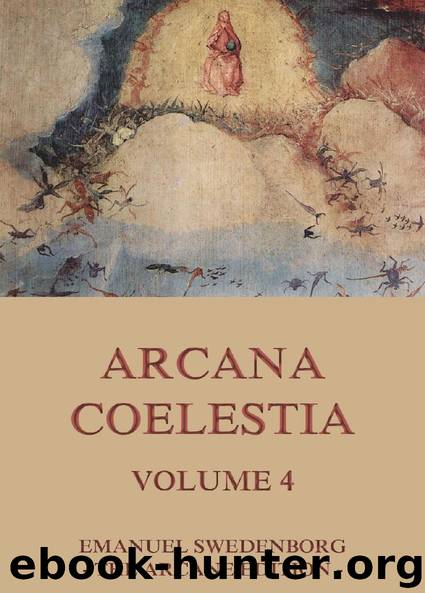Arcana Coelestia, Volume 4 (Extended Annotated Edition) by Emanuel Swedenborg

Author:Emanuel Swedenborg [Swedenborg, Emanuel]
Language: eng
Format: epub
Tags: Religion
Publisher: Jazzybee Verlag
Published: 2013-11-07T00:00:00+00:00
That a "hairy garment" signifies the truth of the natural, is evident from the signification of a "garment" as being that which invests something else, and here therefore it signifies truth, because this invests good; for truth is as a vesture (n. 1073, 2576); or what is nearly the same, truth is a vessel receiving good (n. 1469, 1496, 1832, 1900, 2063, 2261, 2269); and also from the signification of "hairy," as being the natural in respect to truth. "Hair," or the "hair of the head," is frequently mentioned in the Word, and there signifies the natural; the reason is that hair is an excrescence in the outermost parts of man, just as is the natural also relatively to his rational and to the interior things thereof. It appears to man, while he lives in the body, that the natural is his all, but this is so far from being true that the natural is rather an excrescence from his internals, as hair is from the things of the body. The two also proceed from the internals in almost the same way. Hence it is that men who in the life of the body have been merely natural, in the other life, when presented to view in accordance with that state, appear as if covered with hair over almost the whole face. Moreover man's natural is represented by the hair of the head; when it is from good, it is represented by becoming and carefully arranged hair; but when not from good, by unbecoming and disheveled hair. It is from this representative that in the Word "hair" signifies the natural, especially as to truth; as in Zechariah: And it shall come to pass in that day that the prophets shall be ashamed, a man by reason of his vision, when he hath prophesied, neither shall they wear a hairy tunic to deceive (Zech. 13:4). "Prophets" denote those who teach truths, here those who teach falsities (n. 2534); "vision" denotes truths, here falsities; a "hairy tunic" denotes the natural as to truth; and because there was no truth, but rather falsity, it is said, "to deceive." Prophets were clothed with such raiment in order to represent that truth, because it is external. Therefore also Elijah the Tishbite from such clothing is called a "hairy man" (2 Kings 1:8); and John, who was the last of the prophets, had "raiment of camel's hair" (Matt. 3:4). (That "camels" are memory-knowledges in the natural man, may be seen above, n. 3048, 3071, 3143, 3145; and also that memory-knowledges are the truths of the natural, n. 3293.) That the "hair of the head" signified the natural as to truth is plainly evident from the Nazirites, to whom it was commanded that during all the days of their Naziriteship no razor should pass upon their head, until the days were fulfilled during which they separated themselves to Jehovah, and then they should let down the locks of their head, and that then they should shave the
Download
This site does not store any files on its server. We only index and link to content provided by other sites. Please contact the content providers to delete copyright contents if any and email us, we'll remove relevant links or contents immediately.
The Goal (Off-Campus #4) by Elle Kennedy(13543)
Kathy Andrews Collection by Kathy Andrews(11728)
Diary of a Player by Brad Paisley(7487)
What Does This Button Do? by Bruce Dickinson(6134)
Assassin’s Fate by Robin Hobb(6127)
Big Little Lies by Liane Moriarty(5699)
Altered Sensations by David Pantalony(5045)
Pale Blue Dot by Carl Sagan(4912)
Sticky Fingers by Joe Hagan(4100)
The Death of the Heart by Elizabeth Bowen(3551)
The Heroin Diaries by Nikki Sixx(3493)
Beneath These Shadows by Meghan March(3261)
Confessions of a Video Vixen by Karrine Steffans(3243)
How Music Works by David Byrne(3186)
The Help by Kathryn Stockett(3082)
Jam by Jam (epub)(3021)
Harry Potter 4 - Harry Potter and The Goblet of Fire by J.K.Rowling(2990)
Strange Fascination: David Bowie: The Definitive Story by David Buckley(2798)
Petty: The Biography by Warren Zanes(2697)
